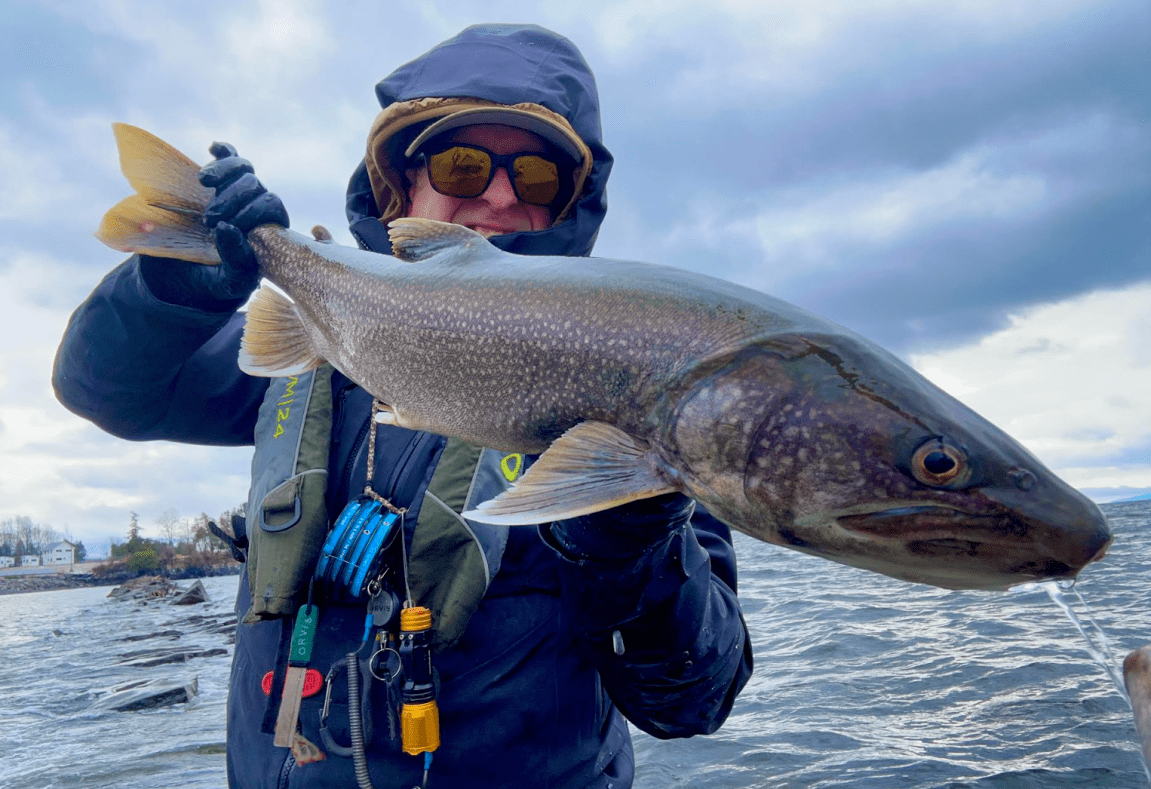Lake trout are denizens of the deep. For most of the year, they’re hunkered down 50 feet or more in the recesses of lakes and reservoirs, chilling out below the thermocline in colder water. To catch them during shorts and T-shirt weather, you’ll need a boat, some quality electronics, heavy jigs, and possibly a set of downriggers for trolling. If you have all that, great. If not, tying into these heavy-hitting predators isn’t usually in the cards. But it can be once T-shirts give way to hooded sweatshirts.
Drew Price is a veteran guide on Lake Champlain, which straddles the border of Vermont and New York, and I recently had him on as a Quick Strike podcast guest. After a summer of chasing bowfin, carp, and gar, he looks forward to the November spawning run that draws monster lakers from Champlain’s depths and puts them in easy casting distance from the bank. Many people who live close to lake trout water don’t even realize this annual bank-fishing opportunity occurs, but during a brief window, you can stick lakers with your feet on terra firma in almost any body of water they inhabit. These pointers from Price will get you on the right track while the getting is still very good.
Where to Find Lake Trout
Dialing in lake trout on foot means paying close attention to water temperatures and studying bathymetric charts for your waters ahead of time, if they’re available. The fish move into prime spawning locations in waves, so it’s possible to pick a few earlier in the fall, then the crescendo of activity will occur, followed by a tapering off action as winter sets in.
“The whole transition actually starts taking place as early as August,” Price says. “Guys who are jigging and trolling start finding out the lakers aren’t in the places they were. They’re already beginning to congregate in the places they want to spawn. But the fish really start becoming accessible to anglers on shore when the water drops below 50 degrees. That’s when the magic happens.”
According to Price, what the fish are looking for are areas rife with rock piles. Important to note is that not all rocky shorelines are created equal. The lake trout need space between the rocks that they can move into and lay their eggs. Areas with slate, sloping rock faces, or mainly small rocks aren’t the ticket. Look for cobble rock, boulder fields, or shorelines with chunky rocks in a variety of sizes. Access to deeper water is most important. Yes, the fish will slide up shallow during the spawn, but they’ll stage in deeper water close by. This makes areas of a lake that have a bottleneck or jutting point matched with the right kind of rocky structures prime for foot missions.
Nighttime Highs & Lows
Chasing lake trout on foot usually requires some bundling and a good set of fingerless gloves. In fact, keeping yourself warm can be the hardest part. Once you find the fish, they won’t be picky. And, if you can brave the extra chill, getting out at night can pay off big time.
“Paddle-tail shads and grubs are probably the most popular lures on Champlain,” says Price. “I’ve had a lot of success with both. My personal favorite is the 5-inch Yamamoto Grub in glow color on a jighead. It’s killer during the day, but it really shines at night.”
Price says some of the best bite windows occur right after dusk and right before dawn. That’s when the fish tend to be most concentrated in the shallower rocks, but he warns anglers to be ethical during these heavy spawning times. It’s not uncommon, he says, for the fish to be so thick and tight to shore that they can easily foul hooked. To avoid this, Price works the outer edges of the direct spawning areas, targeting fish not engaged in the act and often more willing to feed.
Read Next: Best Lake Trout Lures
Keep Flies Simple (But Strong)

Price stressed that it’s a bit silly to lean into expensive lures and flies for shallow lake trout. It’s not that they won’t hit detailed swimbaits or modern flies like the Game Changer, but most of the time the “fancy stuff” won’t outfish much simpler offerings. And when you’re fishing over jagged rocks, you will break off.
“In the fall, don’t throw anything that you’re going to be upset about losing,” he says. “If I’m flyfishing, I’m not throwing a pattern that took me 45 minutes to tie. I’m throwing really simple Clouser Minnows. But I will say, spend the money on good hooks. Lake trout are strong fish, you want a sharp point and strong wire on your fly or jighead. You don’t want to be afraid of losing what you tied on, but you do want to be able to land the fish.”
Price typically rigs up with 15- to 20-pound fluorocarbon leader, mainly because fluorocarbon provides better abrasion resistance than monofilament. He also points out that fishing a longer leader of 9 to 10 feet—even with spinning gear—can be beneficial. At minimum, a longer leader will allow you to retie several times without needing to re-tie an entirely new leader every time the boulders claim another shad or grub.
